by Paul Willis
Anthropomorphic test devices, known colloquially as crash test dummies, are synonymous with automotive testing. But a little-known fact is that the first crash test dummy was used in aerospace.
Sierra Sam as he was known, was created in the late 1940s by American inventor Samuel Alderson to test aircraft ejection seats, aviation helmets and pilot restraint harnesses.
This was some 20 years before dummies were used in the testing of car crashes. More than 80 years later crash test dummies remain an integral part of aerospace testing.
So much so that for NASA’s recent unmanned Artemis-1 mission – a prelude to the eventual manned mission to the moon – three dummies rode onboard to test the impact of space flight on the human body.
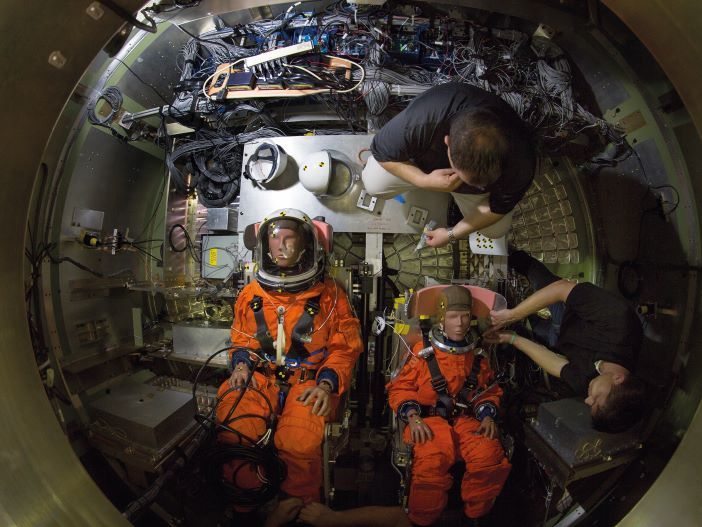
Sensitive dummies
Among the companies that provided Anthropomorphic test device (ATD) equipment for the Artemis-1 mission was California, USA-based DTS, which makes the data acquisition systems (DAQ) and sensors used to collect and store data on the dummies.
The need for DTS’ sophisticated DAQ technology has grown with an increase in the volume of data that today’s dummies are able to collect says Shelly Horvath, DTS’ marketing manager.
“When they started doing tests with ATDs there were maybe 10-30 channels in the ATD,” says Horvath. “Now there might be upwards of 150 sensor channels within a system.”
As well as making today’s generation of ATDs far more expensive – some dummies can cost up to US$1 million – transferring data out of the dummy, a process known as off-boarding, can lead to an accumulation of cumbersome hardware. Namely a bulky array of wiring, says Horvath.
In a typical off-boarding setup each sensor has a cable with an umbilical cord of all the cables emerging from the dummy’s back and feeding into a box, usually located on the backseat of the vehicle in the case of automotive testing.
More than two decades ago, DTS developed a system that dispensed with the cabling by integrating all of the data acquisition system technology inside the dummy itself. This is now known as an in-dummy system and simplifies testing. “We were part of a revolution in making it practical to put all the data acquisition inside the ATD,” says Mike Beckage, DTS’ co-founder and chief technical officer.
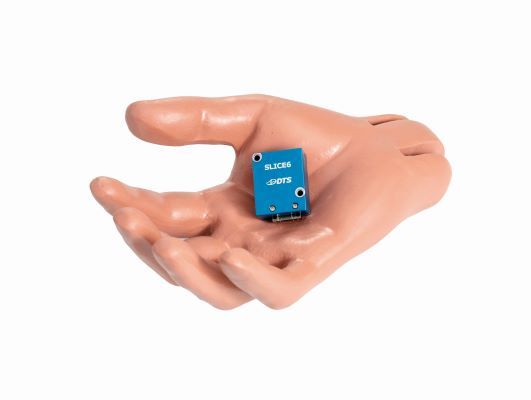
The integration process began in 1997 with the development of the WorldSID dummy, a project led by the ISO standards agency to establish globally harmonized side impact regulations and to improve the assessment of the safety of vehicles in a side impact. “We became one of the development partners along with several other companies both in the USA and Europe,” says Beckage. “And we became the DAQ provider for that dummy development.”
The development of DTS’ in-dummy DAQ technology was helped in large part by advances in semiconductor technology. Beckage says, “Some of the integrated circuits allowed us to build a system that you can fit in the palm of your hand and these can fit into various places in the ATD.”
Skin deep similarities
While the dummies used in aerospace look very similar on the surface to those used in automotive testing, there are some subtle differences in design, says Mark Brown, product marketing manager at Humanetics, one of the world’s largest suppliers of ATDs.
“There are some physical design differences so that particular accelerations and loads are transferred correctly through the dummy,” says Brown. “The biggest difference is that an automotive dummy has a curved lumbar spine, whereas those used in aerospace have straight lumbar spines.”
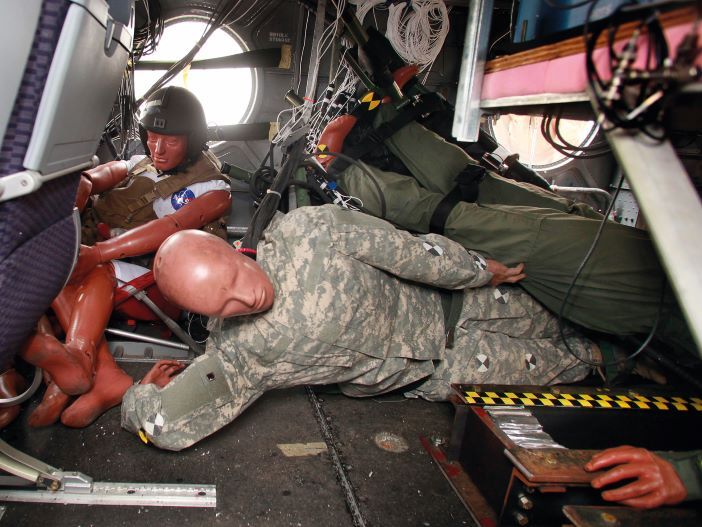
This design difference accounts for the types of forces experienced during flight compared to when driving a car. For example, dummies used in military flight testing “have to be modified so that they can optimize how they measure the vertical loads experienced when a fight pilot ejects,” says Brown.
Humanetics, whose clients include most of the world’s top aerospace companies, produce an aerospace dummy that follows the standards laid down by the US Federal Aviation Administration (FAA), known as the FAA Hybrid 3 50M.
The last two figures in this title refer to the fact that the dummy’s mass and dimensions replicate a 50th percentile male subject, in other words an average-sized man. Humanetics also produces dummies representing the 5th and 95th percentile to “target both the extremes and mid-range of human physiology,” says Brown.
The main purpose of aerospace dummies is to understand how the extreme forces experienced during flight, such as during a crash landing or an ejection impact a human body. To do this the dummies are fitted with an array of sensors. The most common sensor used in ATDs is a load cell to measure the applied forces and force moments experienced during a crash scenario. These forces can cause either compression or strain on the physical structure of the individual load cell unit.
“You can tell from those kinds of measurements if a bone would be broken,” says Brown.
Another common sensor is an accelerometer, which is used to measure the physical speed at which a particular body part speeds up during an impact event. This is especially important when trying to predict head injuries and concussions.
“In the case of the brain, it’s not fixed – it sits inside the skull surrounded by fluid,” says Brown. “So when people get concussions it is because their brain moves around really quick and bangs into the inside of the skull. It’s important to measure how quickly an acceleration ramps up and how much the brain and other organs are being jostled around.”
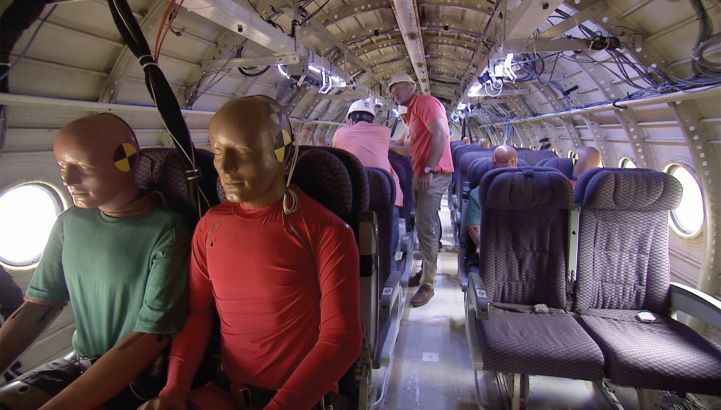
Another sensor embedded in the dummies is an IR-TRACC, (Infra-Red Telescoping Rod for the Assessment of Chest Compression). This device is used to measure the displacement of ribs.
“When you start to get over two inches of compression in the chest area, that’s a threshold where you can start cracking ribs,” says Brown.
Meanwhile pressure sensors are embedded in areas vulnerable to the impact of pressure – the abdomen of a pregnant woman, for example.
Crash resistance
The materials the dummies are made from need to satisfy three main criteria – strength, durability and a similarity in terms of texture and weight to human bodies – a quality known as biofidelity. To ensure strength and durability the internal structure of the dummy is made from metals including aluminum and steel alloys. Urethane foams, plastics and vinyls are used to replicate skin. While “some of the other more compliant parts such as parts of the spine can be made from rubber materials,” adds Brown.
However, the exact specifications of the rubber in different body parts is “very tightly controlled,” Brown says. “The rubber can’t be too stiff or too soft. It has to have the correct compression to give the most accurate indication of how that body part might really react in the human.”
Space launches
DTS provided accelerometer technology for the mannequins that traveled onboard the Orion spacecraft as part of NASA’s recent Artemis-1 mission.
Beckage says, “It is a self-contained data logger that measures acceleration, and it was attached to the seat where one of the dummies was situated at the lower neck level.”
Capable of measuring three different directions of acceleration, data from the device will help NASA understand the impact of shock loading in the vulnerable neck region of the body prior to the manned Artemis-2 launch, which is scheduled to take place next year.
Shock loading, which refers to a sudden and drastic increase of load, can occur at different moments during a space flight including when the capsule parachute opens during re-entry and when the capsule lands on water. DTS’ accelerometer will also be on the Artemis-2 mission, attached to the back of the seats occupied by the four astronauts taking part in NASA’s first manned trip to the moon since 1972. Data collected during the space flight is stored inside the data logger and retrieved when the spacecraft returns to Earth. According to Beckage, no modifications were required to make the device suitable for use during launch and in space.
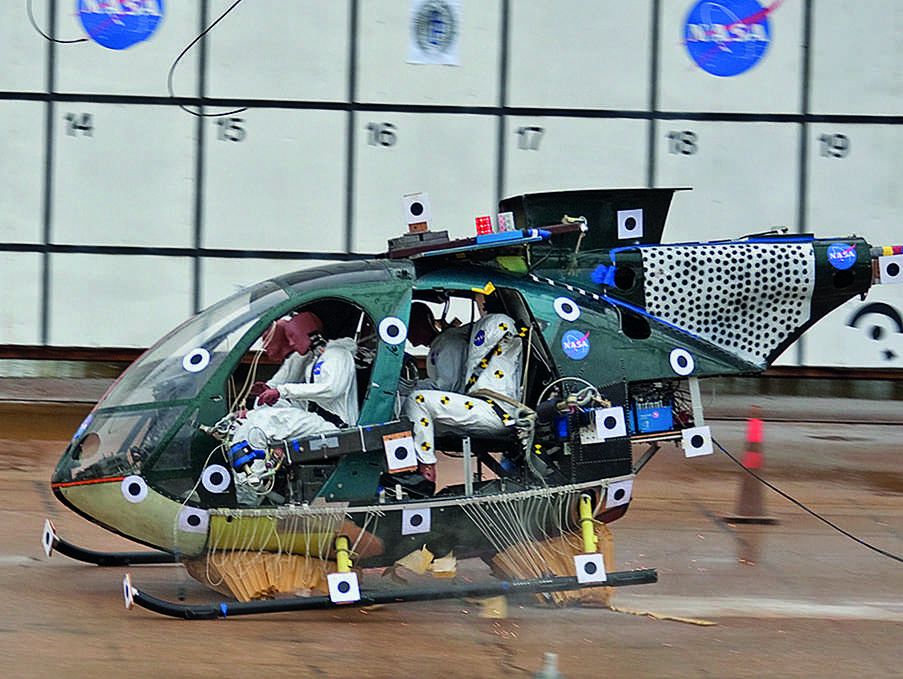
Modeling
While the dummies themselves have become more complex over the years, the impact of other developments in the field of crash testing has had a marked effect on how they are used. The most notable of these developments is the growing use of computer simulation.
“I think when simulation started to become more of a thing 15 to 20 years ago, there was some concern that maybe we were going to get so good at simulating we would not have to physically test as much,” says Beckage.
Ironically, the opposite has turned out to be true. “It means more work for us,” he says. “Because modeling results need to be validated.”
Or as Brown puts it, “A physical test and a simulation need to be connected, they need to complement each other. You can simulate, but you have to understand how things physically react to be able to model anything. You need real-world data to program and construct a virtual model.
“You can start the process with simulation but you will always have to take it back into the real world and get a good physical test. In the ideal situation, they correlate. The model can predict the physical world, and the physical test validates the model.”





